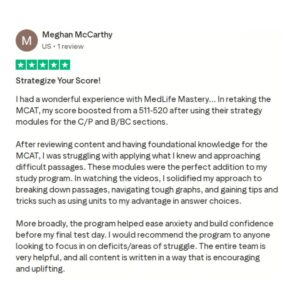Pursuing a medical career is very demanding, and the course alone is tedious and long. Aside from the fact that the medical programs are difficult, you also need to take a qualifying exam for you to get into med school.
Also, for those med students applying for licensure, you need to take not one but a battery of tests to practice medicine. These tests are taken during your med school and while you are still in your residency.
The Medical College Admission Test (MCAT) and the United States Medical Licensing Examination (USMLE) are amongst the standardized examinations suited for those who want to continue their studies in medical schools and get a medical license.
This article will go through the different exam structures, exam fees, and other characteristics of the MCAT and the USMLE. We will give a comprehensive comparison between these two.
What is the MCAT?
It is a standardized exam that is designed for individuals who want to pursue any medical profession, including internal medicine, surgeon, pathologist, pediatrician, cardiologist, and more.
The MCAT is a computerized exam that consists of four test sections, and you are given roughly 7 hours and 30 minutes to finish it. Moreover, the test questions are specifically made to be challenging and tricky to gauge the test-takers comprehension and analyzing skills thoroughly.
It is administered by the Association of American Medical Colleges (AAMC), and it is designed to assess your knowledge of the following fields of science, including Physics, Biology, Chemistry, Psychology, and Sociology.
Furthermore, the MCAT utilizes multiple-choice questions wherein each of its four test sections contains 50+ test questions.The MCAT Four Test Sections are :
What is the USMLE?
It is a three-step examination including USMLE Step 1, USMLE Step 2 CK and CS, and Step 3, which are intended for medical students and those who have already finished their medical course.
The USMLE, or the United States Medical Licensing Examination is a medical licensure exam for medical professionals in the US.
Also, the goal of the USMLE is to assess the individual’s content knowledge of the different branches of sciences, concepts, and principles, which are the fundamentals of medicine. And on how they can apply these learnings in real-life settings.
It is jointly administered by the Federation of State Medical Boards (FSMB) and the National Board of Medical Examiners (NBME). The test duration differs depending on which step of the USMLE you will take, approximately every exam takes about 8 to 9 hours.
The USMLE Three Step Examinations:
- 7 Blocks (Anatomy, Behavioral Science, Biochemistry/Medical Genetics, Microbiology/Immunology, Pathology, Pharmacology, and Physiology)
- 8 Blocks (Internal Medicine, Obstetrics and Gynecology, Pediatrics, Preventive Medicine, Psychiatry, Surgery, and other areas related to providing care under supervision)
- Patient Encounters and Hands-On Examination
- History and Physical
- Lab and Diagnostic Studies
- Diagnosis
- Prognosis
- Pathophysiology
MCAT vs. USMLE: What are the Similarities?
The MCAT and USMLE are similar in the sense that both of them are used in the medical field.
These two exams are trusted by various institutions worldwide to deliver a quality assessment of an individual’s knowledge, skills, and abilities needed to be successful in practicing medicine.
Also, the MCAT and USMLE test an individual's readiness to take a medical course or practice a medical profession.
Regarding their exam contents, they both focus on the different branches of science and principles usually encountered in med school.
Exam Format and Structure: MCAT vs. USMLE
The MCAT and USMLE differ significantly in their exam structure and format. They are similarly taken on computers which is more efficient for their test-takers.
The USMLE is a three-step examination with different test sections per step. And these USMLE tests are taken on different schedules during your stay at the university and not only in one sitting.
The MCAT has only four test sections that measure the student’s problem-solving skills and critical thinking. And also their understanding of the basic science concepts and principles that are encountered in med school.
The USMLE is much longer for the exam length depending on the specific exam you will take. Note that every USMLE test differs in its exam duration and in its test section contents.
For example, in USMLE Step 1, the test duration is approximately 8 hours in total, divided into seven blocks or test sections within 60 minutes given in each block.
In comparison, the MCAT only takes about 7 hours and 30 minutes in one sitting, which means you will complete the whole exam in one day.
Exam Format and Structure | MCAT | USMLE |
|---|---|---|
Test Sections | -Biological and Biochemical Foundations -Chemical and Physical Foundations of Biological Systems -Psychological, Social, and Biological Foundations of Behavior -Critical Analysis and Reasoning Skills | USMLE Step 1: 7 Blocks (Test Sections) -Anatomy -Behavioral Sciences -Biochemistry -Biostatistics and Epidemiology -Microbiology -Pathology -Pharmacology -Physiology USMLE Step 2 CK: 8 Blocks (Test Sections) -Internal Medicine -Obstetrics and Gynecology -Pediatrics -Preventive Medicine -Psychiatry -Surgery -Other areas related to providing care under the supervision USMLE Step 2 CS: -Series of Patient Encounters -Perform Physical Examinations Using Different Tools USMLE Step 3: Day 1 - Foundations of Independent Practice (FIP) -Assessing Knowledge of Diagnosis and Management -History and Physical Examination Diagnosis -Use of Diagnostic Studies Day 2 - Advanced Clinical Medicine (ACM) -Assessment of Knowledge of Diagnosis and Management -Prognosis and Outcome -Health Maintenance and Screening -Therapeutics -Medical Decision Making |
Test Duration | Duration per test section:
90 to 95 minutes each Overall: 7 hours and 33 minutes, including break times. | USMLE Step 1: 8 Hours Divided into Seven Blocks (60 minutes each) USMLE Step 2 CK: 9 Hours Divided into Eight Blocks (60 minutes each) USMLE Step 2 CS: 8 Hours USMLE Step 3: Divided into Two Days: Day 1 - 7 Hours Day 2 - 9 Hour |
Number of Test Questions | 230 Test Questions | USMLE Step 1: 280 test questions USMLE Step 2 CK: 318 test questions USMLE Step 2 CS: 12 Patient Encounters USMLE Step 3: 500 test questions |
Test Frequency | 35 testing dates annually from January to September. | Available all year round |
Test Delivery Mode | Computer-Based Test | Computer-Based Test |
Scoring: MCAT vs. USMLE
These two exams highly differ in terms of their scoring system. The MCAT assigns specific score points for each of its four test sections which range from 118 to 132 points.
All four test sections’ scores will be added to get an overall MCAT score that ranges from 472 to 528 points. The MCAT scores can also be interpreted using the percentile ranks, wherein it is an accumulated score from the previous test-takers of the MCAT.
On the contrary, the USMLE has a different scoring system for each of its three-step exams. For example, USMLE Step 1, is graded with a pass or fail and it is based on a score range between 1 to 300 points wherein the passing score is 196 points.
While the USMLE Step 2 has a similar scoring range between 1 to 300 points but the passing score is 209 points.
In the USMLE Step 2 CS, the scoring is not based on numerical scores instead it is graded only as pass or fail. Also, it is different compared to USMLE Step 1, USMLE Step 2 CK, and USMLE Step 3 scoring systems.MCAT Scoring | USMLE Scoring |
|---|---|
Score Range Per Test Section: 118 to 132 Overall Score Range: 472 to 528 | USMLE Step 1: Graded as Pass or Fail (1 to 300 score range/ 196 passing score) USMLE Step 2 CK: (1 to 300 score range/ 209 passing score) USMLE Step 2 CS: Graded as Pass or Fail USMLE Step 3: (1 to 300 score range/ 198 passing score) |
This is the MCAT Percentile Rank from May 1, 2021, to April 30, 2022. The table below shows the MCAT overall scores with their corresponding percentile ranks. You can use this as a reference for the percentile rank of your MCAT scores.
Overall MCAT Score | Percentile Rank | Header | Overall MCAT Score | Percentile Rank | Header | Overall MCAT Score | Percentile Rank |
|---|---|---|---|---|---|---|---|
472 | <1% | Cell | 491 | 19% | Cell | 510 | 78% |
473 | <1% | Cell | 492 | 21% | Cell | 511 | 81% |
474 | <1% | 493 | 24% | Cell | 512 | 84% | |
475 | <1% | 494 | 27% | Cell | 513 | 86% | |
476 | 1% | Cell | 495 | 29% | Cell | 514 | 88% |
477 | 1% | Cell | 496 | 32% | Cell | 515 | 90% |
478 | 1% | Cell | 497 | 35% | Cell | 516 | 92% |
479 | 2% | Cell | 498 | 38% | Cell | 517 | 94% |
480 | 3% | Cell | 499 | 42% | Cell | 518 | 95% |
481 | 4% | Cell | 500 | 45% | Cell | 519 | 96% |
482 | 4% | Cell | 501 | 48% | Cell | 520 | 97% |
483 | 6% | Cell | 502 | 52% | Cell | 521 | 98% |
484 | 7% | Cell | 503 | 55% | Cell | 522 | 99% |
485 | 8% | Cell | 504 | 58% | Cell | 523 | 99% |
486 | 9% | Cell | 505 | 62% | Cell | 524 | 100% |
487 | 11% | Cell | 506 | 65% | Cell | 525 | 100% |
488 | 13% | Cell | 507 | 69% | Cell | 526 | 100% |
489 | 15% | Cell | 508 | 72% | Cell | 527 | 100% |
490 | 17% | Cell | 509 | 75% | Cell | 528 | 100% |
Test Requirements: MCAT vs. USMLE
Both the MCAT and USMLE utilize online registration for their exams. You can directly visit their official websites to process your exam application.
For the USMLE, you need to check first if your current med school is verified on their website before you proceed to register for the exam.
Also, these two exams differ in their test requirements. The USMLE requires more documents upon registration compared to the MCAT. And, they also have different selections of accepted IDs to support your identity.
You can check the comprehensive table below showing the differences between the MCAT and the USMLE in their respective test requirements.
MCAT Test Requirements | USMLE Test Requirements |
|---|---|
For Online Application -Make an account on the AAMC website. -Fill out the application questions and prompts on their website. -Go to MCAT registration systems and follow the instructions given. Present the following upon registration: 1. Any government-issued IDs (must be valid and not expired) 2. ID must contain a clear photo of you. 3. ID must be in English. 4. Accepted IDs include:
-Driver’s license -Passport -Permanent Resident Card (Green Card) -Employment Authorization Document -Canada Health Car (For Ontario and British Columbia only) -Consular ID -Canadian Aviation Card 5. Submit your academic transcripts (applicable for high school, undergraduate, and any post-graduate education). Also, it accepts unofficial transcripts but must reflect your full name. | For Registration Process: -Apply for an ECFMG Certification. -Status verification of your medical school from the Medical School Web Portal (MSWP). USMLE Online Application: -Register on the official website of ECFMG. Wait for your USMLE ID. -Log in using your USMLE at the NBME website. -Follow the application instructions given. -Wait for the confirmation and scheduling permit email. Present the following upon registration: 1. Send electronic copies of your Certification ID from ECFMG and Authorization Form and include a passport-size picture, and email these to FSM_Records@northwestern.edu. 2. If you have graduated already from med school present the following documents: -Copy of your degree certification and a certified English translation. -Performance transcript from your university. 3. Accepted IDs include:
-Passport -Driver’s License with picture -National Identity card -Any other government-issued IDs |
Test Costs: MCAT vs. USMLE
The USMLE and MCAT significantly differ in terms of their exam fees and mode of payment. The USMLE costs USD 985 for the USMLE Step 1, USMLE Step 2 CK, and USMLE Step 2 CS.
And for the USMLE Step 3, it costs around USD 895 for applications made in 2022 and for 2023 applications it costs USD 915. The cost of the USMLE exams is quite expensive compared to the MCAT which only costs USD 310.
These two exams also differ when it comes to their payment modes. For instance, the MCAT only accepts payments made using credit and debit cards. While the USMLE accepts payments thru credit cards, debit cards, money order, and more.
Here’s a comprehensive table reflecting their cost differences and payment options.
MCAT Fee | USMLE Fee | |
|---|---|---|
Payment Modes | Only accepts credit or debit cards (American Express, VISA, MasterCard) | -Accepts credit cards (Visa, MasterCard, Discover, American Express) -Accepts electronic checks (for US Banks only) -Accepts payment thru bank drafts/money order (must be in US dollars only) |
Cost | USD 310 | USMLE Step 1: USD 975 USMLE Step 2 (CK and CS): USD 975 USMLE Step 3: USD 895 (for 2022) USD USD 915 (for 2023) |
Test Recognition: MCAT vs. USMLE
The MCAT and USMLE are the two tests that are widely used by most medical schools for admission and medical licensure.
Australia, Ireland, Israel, United Arab Emirates (UAE), New Zealand, Qatar, and the United Kingdom are the countries worldwide that accept and recognized the USMLE as a national medical exam.
In the United States alone, it is considered a board exam for medical licensure. It is highly required for you to take this exam so you can practice medicine in the US.
It is a prerequisite exam for you to enroll in any medical school of your choice.
Below are some medical schools in Australia that require the MCAT.Below are some medical schools in the USA that require the MCAT.
Below are the top schools in the USA that recognize and accept the USMLE.
Which is Easier: MCAT vs. USMLE
The USMLE is a much harder and more complicated exam compared to MCAT. Though the MCAT is known to be a difficult admission test, the USMLE is much more challenging.
The USMLE intends to measure the readiness of its test-takers to practice medicine. Also, the test contents and questions are a much more in-depth approach in comparison to MCAT’s test questions.
Also, the MCAT objective is to measure the test taker’s knowledge of the fundamentals of science and other scientific principles relevant to the medical profession which is a basic requirement whenever you want to get into med school.
Thus, the big difference between the MCAT and the USMLE, makes the latter a difficult exam for most.
Should You Take the MCAT vs. USMLE?
You can either take the MCAT or the USMLE depending on your need and intentions. If you are already a medical practitioner based in another country and want to continue practicing your profession in the US, you need to take the USMLE.
Moreover, the USMLE is a licensure exam for medical professionals. It tests your learning in med school and skills if you are ready to practice your medical profession.
If you are just planning to enroll in medical school, you should take the MCAT. These two exams serve different purposes, so you should take the one that fits your need.
Summary Table of Differences: MCAT vs. USMLE
Below is the table of differences between the MCAT and the USMLE.
MCAT | USMLE | |
|---|---|---|
Test Sections | -Biological and Biochemical Foundations -Chemical and Physical Foundations of Biological Systems -Psychological, Social, and Biological Foundations of Behavior -Critical Analysis and Reasoning Skills | USMLE Step 1: 7 Blocks (Test Sections) -Anatomy -Behavioral Sciences -Biochemistry -Biostatistics and Epidemiology -Microbiology -Pathology -Pharmacology -Physiology USMLE Step 2 CK: 8 Blocks (Test Sections) -Internal Medicine -Obstetrics and Gynecology -Pediatrics -Preventive Medicine -Psychiatry -Surgery -Other areas related to providing care under the supervision USMLE Step 2 CS: -Series of Patient Encounters -Perform Physical Examinations Using Different Tools
USMLE Step 3: Day 1 - Foundations of Independent Practice (FIP) -Assessing Knowledge of Diagnosis and Management -History and Physical Examination Diagnosis -Use of Diagnostic Studies Day 2 - Advanced Clinical Medicine (ACM) -Assessment of Knowledge of Diagnosis and Management -Prognosis and Outcome -Health Maintenance and Screening -Therapeutics -Medical Decision Making |
Test Duration | 7 hours and 33 minutes, including break times. | USMLE Step 1: 8 Hours Divided into Seven Blocks (60 minutes each) USMLE Step 2 CK: 9 Hours Divided into Eight Blocks (60 minutes each) USMLE Step 2 CS: 8 Hours USMLE Step 3: Divided into Two Days: Day 1 - 7 Hours Day 2 - 9 Hour |
Number of Test Questions | 230 Test Questions | USMLE Step 1: 280 test questions USMLE Step 2 CK: 318 test questions USMLE Step 2 CS: 12 Patient Encounters USMLE Step 3: 500 test questions |
Scoring System | Score Range Per Test Section: 118 to 132 Overall Score Range: 472 to 528 | USMLE Step 1: Graded as Pass or Fail (1 to 300 score range/ 196 passing score) USMLE Step 2 CK: (1 to 300 score range/ 209 passing score) USMLE Step 2 CS: Graded as Pass or Fail USMLE Step 3: (1 to 300 score range/ 198 passing score) |
Test Frequency | 35 testing dates from January to September. | Available all year round |
Exam Cost | USD 310 | USMLE Step 1: USD 975 USMLE Step 2 (CK and CS): USD 975 USMLE Step 3: USD 895 (for 2022) USD USD 915 (for 2023) |
Mode of Payment | Only accepts credit or debit cards (American Express, VISA, MasterCard) | Accepts credit cards, electronic checks, and payments thru bank drafts/money orders. |
Scoring | Score Range Per Test Section: 118 to 132 Overall Score Range: 472 to 528 With percentile ranks | USMLE Step 1: USD 975 USMLE Step 2 (CK and CS): USD 975 USMLE Step 3: USD 895 (for 2022) USD USD 915 (for 2023) |
Additional FAQs – MCAT vs. USMLE
Do I Need the MCAT for the USMLE?
These two exams differ in their purpose, for example, the MCAT is a standardized examination for every medical school in the US and other countries.
In contrast, the USMLE is a medical licensure exam for those who recently finished med school and for other medical practitioners who want to practice in the US.
Does the MCAT Predict USMLE?
On the contrary, the knowledge and skills that you acquired during your time in med school also is a big contributing factor for you to be successful in taking the USMLE. That is why your MCAT scores are not the only thing that can predict how well you performed in the USMLE.
The MCAT or the USMLE, Which is Better?
On the other hand, if you want to get a medical license for you to practice your profession, you may take the USMLE, since it is a licensure exam for medical practitioners.


 To help you achieve your goal MCAT score, we take turns hosting these
To help you achieve your goal MCAT score, we take turns hosting these 















